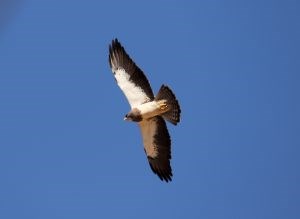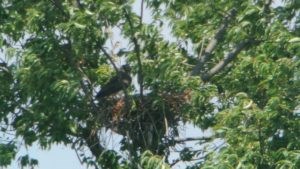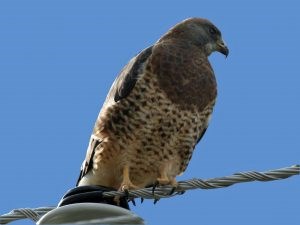This content was originally published by the Longmont Observer and is licensed under a Creative Commons license.
Spring has finally arrived, and I am beginning to see many more hawks migrating through. One of these, the Swainson’s hawk, is my among my favorites. I’ve seen several in Longmont on their way through over the past week.
The Swainson’s hawk is returning from it’s yearly migration to South America. Every year, Swainson’s hawks travel over 6,000 miles one way to reach their wintering grounds. In terms of raptors, only the Arctic Peregrine falcon travels farther. Thousands of Swainson’s hawks congregate together making for a truly impressive sight.
The hawk is named after William Swainson, the person who drew the first illustrations.
Swainson’s hawks can occur in several different plumages, called polymorphisms or morphs. This can make them confusing to identify and they are often mistaken for broad-winged, white-tailed, or short-tailed hawks.
I will describe the adult light morph as it is the easiest to identify. The Swainson’s hawk is a relatively large bird weighing between 1.7 to 2.5 pounds. For comparison, Swainson’s hawks are larger than a crow but smaller than a goose. Females are larger than males.
Swainson’s hawks have an average wingspan of 15-16 inches. In flight, the wings are long and broad with pointed tips. When soaring, Swainson’s hawks hold their wings in a slight “V” shape called a dihedral. Looking at the hawk from below when it is flying, the wings have a dark edge against white. Swainson’s hawks in the light morph have a cream-colored belly with a dark brown bib. The wings and back are brown or gray. Males tend to have gray heads whereas females tend to have brown heads.

Swainson’s hawks prefer open habitats with scattered trees and can often be seen perching next to a field on a telephone pole or a fence. Much of the habitat Swainson’s hawks use has been converted into agricultural land to which they have adapted. They are found on the plains and in dry grasslands as well.
Swainson’s hawks have interesting eating patterns. When they are feeding young, they will prey on rabbits, rodents, and reptiles. However, when there are no young present, they feed primarily on large insects, including grasshoppers. This is how they got their nickname the “grasshopper hawk.” One hawk can eat up to 100 grasshoppers per day!
They also prey on dragonflies and insect larvae. Swainson’s hawks will often follow farm equipment working in the fields to catch rodents that have been disturbed or to find insect larvae that have been exposed. When hunting mammals or reptiles, Swainson’s hawks often search for prey from a perch or they may fly low over the ground. They may perch on the ground next to rodent burrows. Swainson’s hawks are also capable of catching flying insects in the air.

Swainson’s hawks breed usually beginning in April. They have very acrobatic courtship displays. Both the male and female soar in a circle high above the nest site. Next, one of the pair folds its wings back along its body and dives rapidly, recovering before hitting the ground. Eventually, the male will end the display by perching near the nest site which he has chosen. Swainson’s hawks are monogamous and will stay with the same mate for at least several seasons.
Nests are typically located in trees 15-30 feet above the ground. Nests are usually hidden by foliage and are constructed as a platform of large sticks lined with smaller twigs and weeds. Fresh leafy branches may also be woven into the nest. Swainson’s hawks have also been known to build nests in shrubs or hedgerows.
Both members of the pair help build the nest which takes between 1-2 weeks to complete. The male brings most of the nesting material to the nest. Nests may sometimes be built on top of old magpie, crow, or raven nests. The completed nest is almost two feet in diameter and about a foot high with an inner cup that is eight inches across and three inches deep. Nests may be reused between years.

The female lays between one and five eggs with the average being two or three. Eggs are pale bluish-white in color with light brown spots. Incubation is done primarily by the female and lasts for 34-35 days. While the female is incubating the eggs, the male brings food to the nest.
The young are born naked and helpless (altricial). Once the eggs hatch, the female will brood the young for the first few days while the male hunts and brings food back to the nest. Eventually, both members of the pair will bring food to the young. At 42-44 days after hatching, the young are able to fly. However, they usually remain with the pair until the fall migration.
During the 1990s, the population of Swainson’s hawks began to decline rapidly. The cause was traced to pesticide use on sunflower seeds in South America. When hawks ate the poisoned insects, they became sick as well and large numbers died. Since that time, most use of that particular pesticide has stopped and numbers have stabilized.
At this time of the year, you can look for Swainson’s hawk flocks (called kettles) migrating through. From a distance they may appear very similar to migrating turkey vultures. You are likely to see them perched on utility poles around the edges of town where there are open fields for them to hunt in. I often see them perched along 119 east of town. You may also be lucky enough to hear their iconic kreee call. During the summer, don’t forget to scan the fields for Swainson’s hawks hunting on the ground. These are beautiful birds, so keep your eyes peeled!


